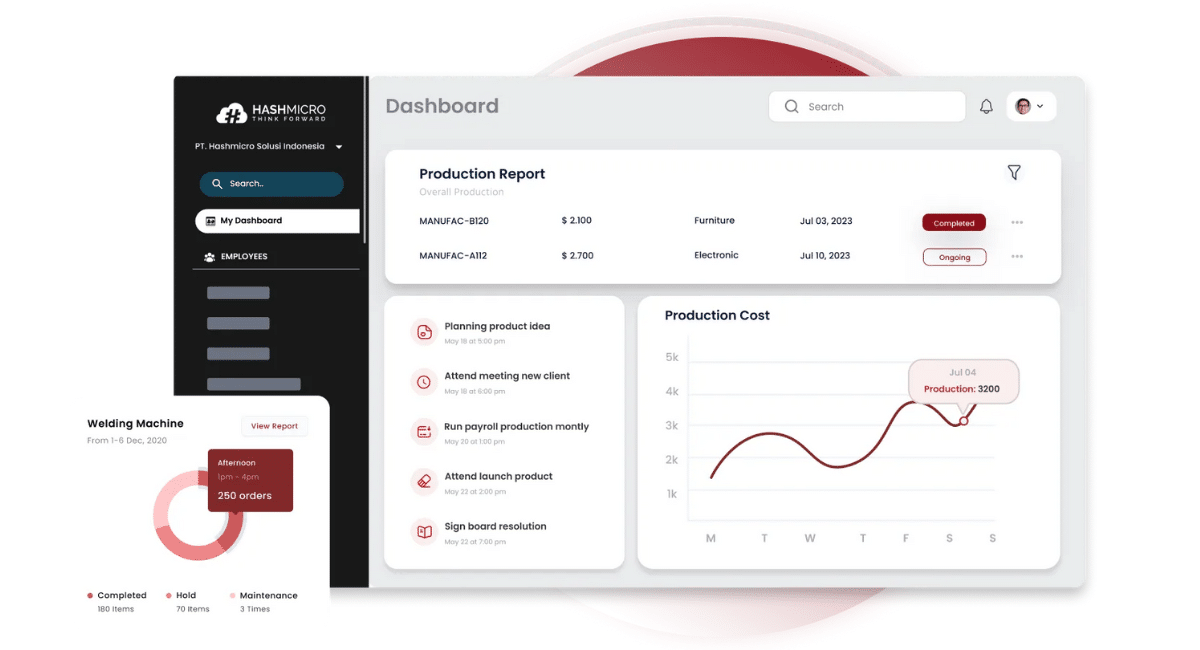In the heart of Singapore’s thriving business district, where time is as valuable as currency, the concept of ‘takt time’ emerges as a game-changer for enterprises aiming to streamline their operations. However, when these measures do not align with customer demand, succumb to inefficiency, and struggle with inflexibility, it signals a deeper level of discomfort within the production line.
One way to optimize it is by implementing automated systems. Optimizing takt time through automated methods has led to a 20% surge in line productivity and a 25% reduction in production time for manufacturers.
Let’s explore how implementing takt time can keep your business in sync with customer demand and propel you ahead of the competition.
Table of Content:
Table of Content

Key Takeaways
|
What is Takt Time?
In the dynamic manufacturing world, ‘takt time’ is the golden measure that aligns production with customer demand. The term has its roots in the German word ‘Taktzeit,’ which translates to ‘cycle time.’ This timing is how a product must be completed to meet customer demand.
It’s calculated by dividing the available production time by the customer’s required units. For example, if you have 480 minutes of production time and a demand for 240 units, your takt time is 2 minutes per unit.
When finely tuned, the production line flows smoothly, each widget is produced at just the right interval, and inventory levels are lean. This is the sweet spot, where studies have shown that optimizing takt time can lead to a 20% increase in productivity and a 25% reduction in production time.
Conversely, when ignored, the production line is erratic, leading to overproduction or shortages. This dissonance results in increased storage costs, potential waste of unsold products, and unhappy customers. The lack of synchronization with customer demand can cause a significant drop in efficiency and profitability.
In essence, takt time is the heartbeat of lean manufacturing. It ensures that the production process is efficient and responsive to customer needs. It’s not just about keeping up with the pace; it’s about setting the pace for success.
Understand the Differences Between Takt Time, Cycle Time, and Throughput Time
In the bustling manufacturing world, understanding the difference between takt time, cycle time, and throughput time can be the key to unlocking peak efficiency. Let’s break it down with some easy-to-digest examples.
Takt time is the rate at which production must be completed to meet customer demand. So, how is it calculated?
For example, if your production time is 460 minutes and you need to produce 92 units to meet daily orders, here is your calculation:
Talk Time = 460 minutes / 92 units = 5 minutes
Cycle time, on the other hand, is the actual time it takes to make a product from start to finish. For instance, if it takes 30 minutes to assemble a widget, that’s your cycle time.
Throughput time is the total time a product takes to move through the entire production process, including processing, inspection, moves, and queues. Imagine a product that takes 2 minutes to process, 1 minute for inspection, 3 minutes to move between stages, and spends 4 minutes in the queue.
The throughput time would be:
Throughput Time = (2+1+3+4) minutes/number of units produced
So, why does this matter? By fine-tuning each of these times, a manufacturer can ensure they’re making products efficiently and in tune with what their customers want.
Benefits of Takt Time
Regarding manufacturing, ‘takt time’ is more than just a buzzword—it’s a transformative approach that can yield remarkable benefits. Optimizing it aligns production with customer demand, creating a steady and efficient workflow that significantly enhances productivity.
For instance, consider the benefit of improved production efficiency. By optimizing this timing, manufacturers can reduce waste, increase flow, and synchronize production processes with customer demand.
This means that every part of the production line works in harmony, much like musicians in an orchestra, each playing their part at the right time to create a symphony of efficiency.
Another key advantage is reduced waste and inventory. By optimizing this timing, production is tailored to match customer demand, eliminating the need for excess inventory and reducing the waste produced by overproduction.
Imagine a toy manufacturer adjusting its pace before the holiday season. By doing so, it produces just enough toys to meet the surge in demand, avoiding overproduction and the subsequent need to discount or store unsold stock.
Lastly, enhanced customer satisfaction is a significant benefit. When production processes are in sync with customer demand, the result is timely deliveries and high-quality products. Picture a furniture company that optimizes its takt time; customers receive orders promptly, leading to rave reviews and repeat business.
When to Implement Takt Time in Manufacturing
When it comes to implementing takt time in manufacturing, timing is everything. It’s not just about what it is; knowing when to integrate this powerful tool into your production process can make all the difference.
Here are some key moments when implementing takt time is most beneficial:
- Need for process synchronization: When your production line consists of multiple stages that need to work in concert, takt time is your maestro. It helps align various stages of production, ensuring a smooth flow of operations. This is particularly crucial when you’re looking to streamline complex processes where timing discrepancies can lead to bottlenecks.
- Improving production efficiency: If you notice that your production isn’t as efficient as it could be, tact time can help identify and eliminate waste. By setting a pace that matches customer demand, you ensure that every part of your process contributes to output without any excess or shortfall.
- Customer satisfaction focus: In today’s fast-paced market, meeting customer demand promptly is key to satisfaction. Takt time allows you to adjust your production rate to meet these demands accurately, enhancing your reputation and customer loyalty.
- Standardization of processes: For businesses looking to standardize their production processes, this pace measurement provides a quantifiable and consistent metric to measure and maintain the pace of work. This standardization can lead to improved quality control and a more predictable output.
- Complex supply chains: When a supply chain involves multiple steps, suppliers, or locations, this pace standard can help synchronize these elements. This synchronization is essential for minimizing delays and ensuring the final product is assembled on time.
The best way to optimize it is by using manufacturing ERP software. HashMicro’s manufacturing ERP system is engineered to be the linchpin in your quest for optimal takt time. Download the pricing scheme today to truly understand the value HashMicro can bring to your business.
The Challenges in Implementing Takt Time
Implementing this timing in a manufacturing environment comes with its own set of challenges. While the benefits of taking time are clear, the path to its successful integration can be strewn with obstacles that businesses must navigate carefully.
One of the primary challenges is variability in production. Any inconsistency on the shop floor, whether in product quality, processing times, or disproportionate workloads at workstations, can hinder the ability to meet takt time benchmarks.
For example, if one station in an assembly line takes longer than the total time to complete its task, it creates a bottleneck that slows the entire production process.
Another significant challenge is managing increased demand. When customer demand spikes, maintaining the established takt time requires scaling up production without compromising quality or efficiency. This often means investing in additional resources or re-engineering processes, which can be costly and complex.
Resource constraints also pose a considerable challenge. Limited equipment, materials, or skilled labor can create bottlenecks at critical stages of the production process, causing delays and disrupting workflow. Organizations must carefully assess resource availability and allocation to ensure time implementation does not falter due to such constraints.
Moreover, implementing takt time can result in stress on production elements. The pressure to keep up with the set pace can lead to overworked employees and machinery, potentially resulting in burnout or equipment failure. This stress can also affect product quality and lead to higher defect rates.
Lastly, the complexity of supply chains can complicate the time implementation. With multiple suppliers and steps involved, synchronizing every element to adhere to the takt time can be daunting. Any disruption in the supply chain can have a ripple effect, impacting the entire production schedule.
In conclusion, while it can significantly enhance manufacturing efficiency, businesses must approach its implementation with a strategic plan to overcome these challenges.
To ensure that takt time becomes a beneficial tool rather than a hurdle, it requires a thorough analysis of existing processes, a clear understanding of demand patterns, and a commitment to continuous improvement.
Optimize Takt Time Using HashMicro’s Manufacturing ERP Software
HashMicro is a cornerstone of production efficiency, particularly in optimizing takt time. Trusted by over 1,750 world-class enterprises, HashMicro offers a suite of more than 40 localized modules designed to cater to a diverse range of business needs.
Their clientele includes prestigious names such as Changi Airport Singapore, Forbes, and Bank of China, showcasing the software’s capability to serve various industry giants.
The flexibility of HashMicro’s manufacturing ERP software is evident in its ability to be customized and integrated with third-party applications or existing systems, ensuring a tailored fit for every business.
Here are some key features of HashMicro’s manufacturing ERP software for takt time optimization:
- Manufacturing production scheduling: Aligns production schedules with customer demand, consistently meeting the set timing.
- Manufacturing Gantt chart schedule management: This provides a visual representation of production schedules against time, highlighting discrepancies and areas for improvement.
- Secret recipe (BoM): Maintains consistency in production specifications, which is essential for predictable takt time adherence.
- Manufacturing requisition planning: Facilitates timely material availability, preventing production delays.
- Manufacturing quality control: Ensures product quality consistency, reduces rework, and keeps production within set takt time.
- Conveyor belt sensor IoT integration: This system utilizes real-time data to adjust the timing dynamically, maintaining alignment with actual production rates.
By integrating these features, HashMicro’s ERP system streamlines the manufacturing process and turns time optimization into a strategic advantage, propelling businesses toward greater productivity and efficiency.
Conclusion
As we’ve explored throughout this article, takt time is more than a manufacturing metric; it’s a strategic approach that can significantly impact the efficiency and success of Singaporean businesses.
Aligning production with customer demand, this timing ensures that resources are utilized effectively, waste is minimized, and customer satisfaction is maximized. In the competitive landscape of Singapore’s manufacturing sector, mastering this timing can be the difference between thriving and merely surviving.
For businesses ready to harness the full potential of takt time, HashMicro’s manufacturing ERP software presents an unparalleled solution. With its advanced features designed to fine-tune your production process, HashMicro provides the tools necessary to achieve a seamless, efficient, responsive manufacturing operation.
Discover the power of HashMicro’s ERP software—access the free demo today and take the first step towards optimizing your takt time and elevating your business to new heights. The time to act is now.
FAQ about Takt Time
-
How is Takt Time applied in project management?
Takt Time can be effectively used in project management to determine the pace at which work needs to be completed to meet project milestones and deliverables. By aligning the project’s timeline with this timing, project managers can allocate resources efficiently, ensuring that each phase of the project is completed on time and helping to keep the project on track and within scope.
-
Can Takt Time be implemented in service industries?
Yes, it applies to service industries such as healthcare, hospitality, and financial services. It helps synchronize service delivery with customer demand, ensuring services are provided efficiently and promptly. This can lead to improved customer satisfaction and better resource utilization.
-
How can Takt Time be used in high-mix, low-volume production environments?
Due to varying product demands, implementing this timing can be challenging in high-mix, low-volume production environments. One approach is calculating a “pitched” Takt Time based on average demand rates or adjusting it for different product families. This allows flexibility in balancing workloads and sequencing tasks, helping manage diverse production requirements effectively.
-
What lean tools and techniques can optimize Takt Time?
Several lean tools and techniques, including value stream mapping, continuous flow, standard work, mistake-proofing, and level loading, can help optimize Takt Time. These methods streamline processes, eliminate waste, and ensure production aligns with customer demand, enhancing overall efficiency and productivity.
-
What is the relationship between Takt Time and cycle time?
Takt Time and cycle time are closely related but distinct concepts. The first one refers to the rate at which products or services must be completed to meet customer demand, while cycle time is the time taken to complete a specific task or process. Managing both metrics is essential for optimizing production efficiency and meeting customer expectations.




































